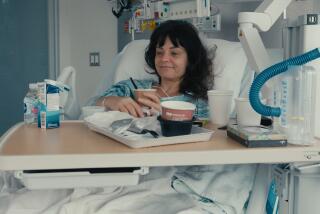Transplant Nurse Pulls ‘Gift of Life’ From Death : Medicine: Matching donors with recipients is a complex, sensitive task. The work is almost always a race against time.
- Share via
BOISE, Ida. — Virginia Zimmer watches for death.
It’s grim work, but she can’t let death have the final say.
At St. Alphonsus Regional Medical Center, Zimmer matches organ donors with people from all over the country who also watch for death.
There are miracles, and she somehow finds ways to turn grief and tragedy into joy.
“I tell people it’s the gift of life--it’s the finest gift we can give,” she said.
For the thousands of seriously ill with diseased hearts, kidneys and livers, the choice is simple--a transplant or death. They wait anxiously for the call that another person has died so they might live.
The donors share a profile. They die quickly, violently. It may be a traffic accident, a blood vessel exploding in the brain, a suicide. In any event, the brain is destroyed while the organs still function.
Almost always, they’re young.
“They’re 16- to 20-year-olds. . . . That’s why it’s difficult. They’re the hope of the family. They die, and it’s tough,” said Zimmer, 55.
The awful moment comes when the family is told their loved one is dead. Machines can maintain the organs in a brain-dead person for a couple of days at most. Zimmer must work quickly, compassionately.
Gently, she tells the family of the donor program. She answers questions. The grieving struggle to understand.
“Eighty percent say yes,” she said. “I’ve never had anybody get angry with a request to donate. They can only say no.”
In 1986, Zimmer volunteered to coordinate organ donation at St. Alphonsus on top of her regular duties as a nurse educator. Her 24 years as an intensive-care nurse were ideal training.
The volunteer work grew into the full-time position she assumed in August, working with all the hospitals in southwestern Idaho. A top priority for Zimmer is to educate the public about the donor program.
Her first year, she managed 13 donor cases. There were 14 the following year. Then eight. And only four donors so far this year.
In any given year, only 8,500 to 12,000 people can be considered to be donors, says Wanda Bond, a spokeswoman for the United Network for Organ Sharing in Richmond, Va.
“It may be that hospitals already burdened with bureaucracy and red tape see the donor program as just one more thing to do,” Bond said. She also thinks stricter drunk-driving laws, higher seat-belt use and motorcycle helmet laws all may affect the number of available donors.
Nationally, donors of solid organs such as the heart, lungs, liver, kidneys and pancreas fell from 3,975 two years ago to 3,898 in 1989. Yet the number of transplants rose more than 5% to 13,384, through multiple use of donor organs.
Zimmer says up to half a dozen recipients may benefit from the organs of one donor. A donor also can provide eyes for cornea transplants, bone to graft onto shattered limbs and skin to protect burn patients.
“When they can donate, it helps the donor family almost as much as the recipient family,” Zimmer said.
After a patient has died and permission is obtained from relatives to donate organs or tissue, an intricate choreography involving scores of people is performed. Most of the work must be done within 12 to 18 hours.
“We treat (the donor) respectfully,” said Merry Reed, an intensive-care nurse at St. Alphonsus. “But we can’t treat them as though they’re going to get well. Now you’re working to save another life--or three or four lives--with the organs.”
If the heart or other organs have been donated, Zimmer is on the phone with the national organ-sharing network for its lists of the people needing organ transplants.
The lists are brutally efficient. Only the most feeble rise to the top. The likelihood of survival through an organ transplant increases only as a person’s medical condition deteriorates.
Lab work is done to check for hepatitis and AIDS. Blood pressure is stabilized. The chest is measured. The kidneys are kept working. Organ recovery teams fly in from Salt Lake City or Portland, Ore.
A heart must be transplanted within four hours after being removed from a donor. Lungs, two hours. A liver, 24 hours. Kidneys, 72 hours.
More than 17,000 people in the United States are waiting for kidney transplants. Nearly 1,000 need liver transplants. An additional 1,700 need hearts.
Nine months ago, Virginia Zimmer’s own son, Joe, died in a car wreck. He was 28 and strong, a former Marine. The nurses at St. Alphonsus, out of respect for their co-worker’s feelings, didn’t ask her the obvious question.
Zimmer, in her grief, didn’t remember until it was too late.
“I could have donated his eyes,” she said.
She pauses.
“The ones who feel badly are the ones who weren’t asked.”






